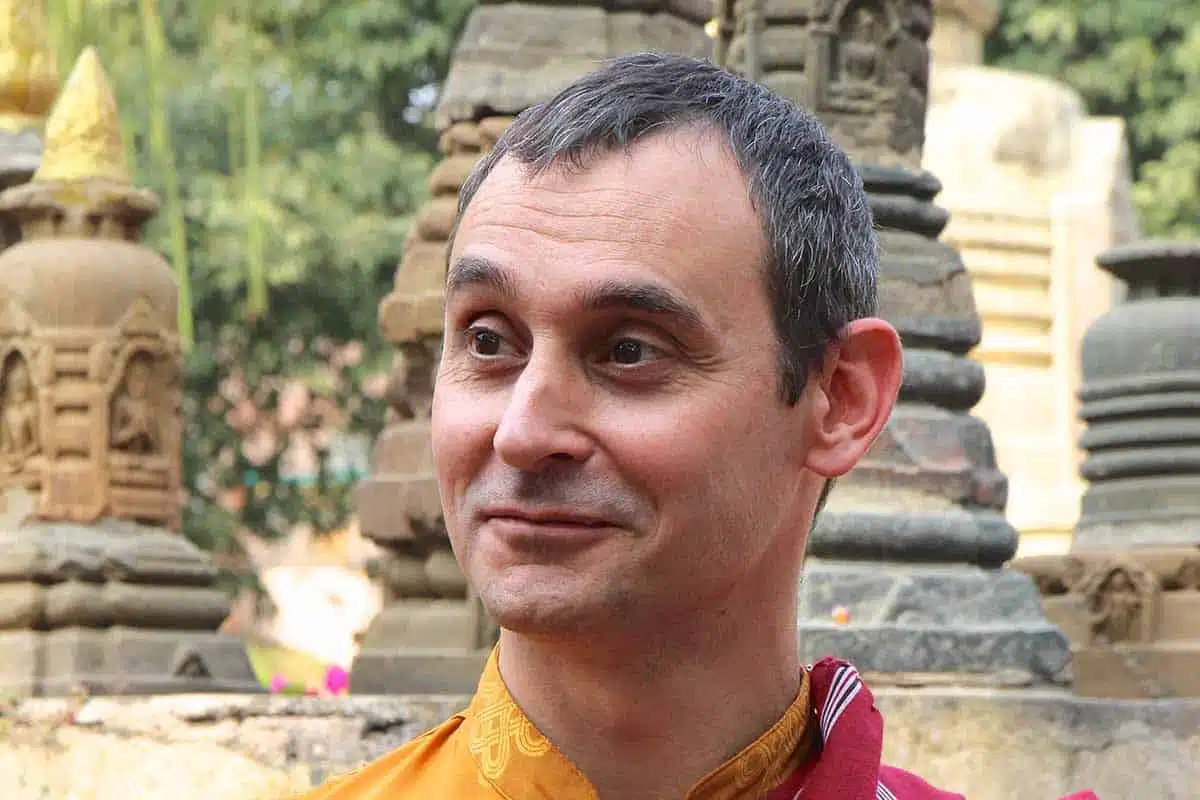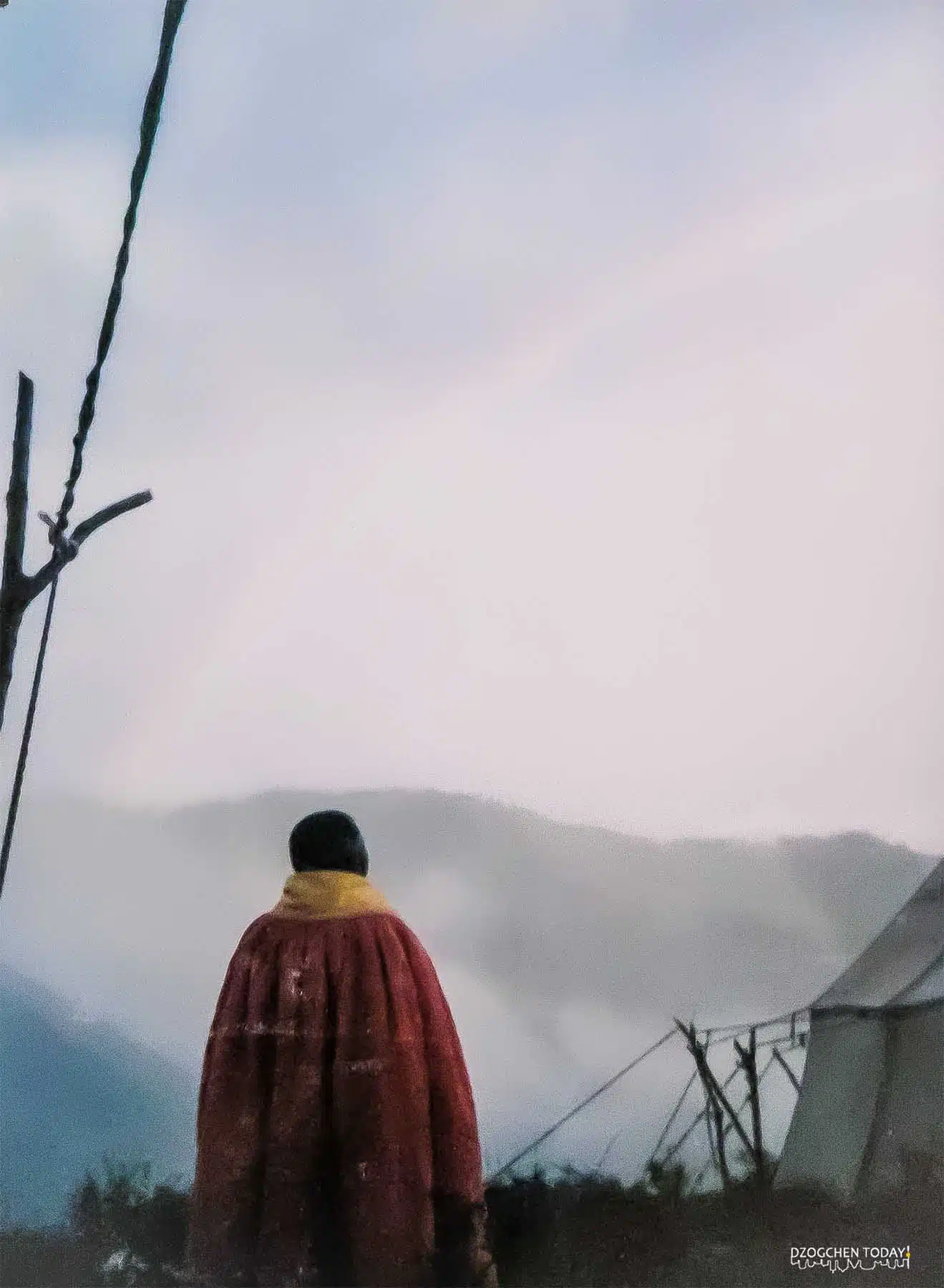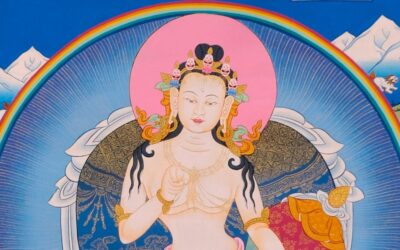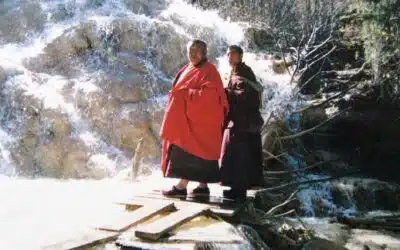The Call of the Lineage

Written By Mila Khyentse
Blog | Culture and tradition | The Dzogchen Journey
Series: The Lineage
The Call of the Lineage
It was in the early 2000s. One day, I received a message from a Lama friend who said, in essence, “One of my students has just met a Dzogchen master in Amdo [1]. She showed him our photos, and he is asking you to come and be the next holder of his lineage.” It was completely unexpected, and those few words changed the course of my life.
So I set off to join the one who would become my root master in the Great Perfection tradition, Lobsang Dargye Gyamtso Rinpoche, also known as Alags Chörten [2]. I didn’t hesitate, leaving the life I had led until then without any regrets. I thus followed the call of the lineage, as many others before me had done. It may seem crazy, but it was truly the best thing I could have done in my entire life.
“The strength and blessing of the lineage are like the sun rising in the midst of darkness. When we connect with all the masters of the past, our confusion disappears and our doubts fly away, our suffering subsides on its own, and the vision of our true nature emerges spontaneously.”
Lobsang Dargye Gyamtso Rinpoche, aka Alags Chörten – circa 1980
རྒྱུད་པའི་གསོལ་འདེབས་ནི།
Lineage supplication
༄༅། །ཨེ་མ་ཧོཿ རྒྱ་ཆད་ཕྱོགས་ལྷུང་བྲལ་བའི་ཞིང་ཁམས་ནས༔ །དང་པོའི་སངས་རྒྱས་ཆོས་སྐུ་ཀུན་ཏུ་བཟང་༔
E ma ho/ gya ché chog lhung drèl wé shing kham né/ dang pö sang gyé chö ku kün tu zang/
How marvellous! From the Pure Land, free of concepts of partiality and direction, first is Buddha Samantabhadra, the Dharmakāya.
།ལོངས་སྐུ་ཆུ་ཟླའི་རོལ་རྩལ་རྡོ་རྗེ་སེམས༔ །སྤྲུལ་སྐུར་མཚན་རྫོགས་དགའ་རབ་རྡོ་རྗེ་ལ༔
long ku chu dé röl tsèl dor jé sèm/ trül kur tshèn dzog ga rab dor jé la/
Then, like the reflection of the moon on water, is Dorje Sempa (Vajrasattva) [3], the Sambhogakāya, and Garab Dorje (Prahevajra), adorned with the marks of perfection, the Nirmanakāya.
།གསོལ་བ་འདེབས་སོ་བྱིན་རླབས་དབང་བསྐུར་སྩོལ༔ །ཤྲཱི་སིང་ཧ་དོན་དམ་ཆོས་ཀྱི་མཛོད༔
söl wa dèb so jin lab wang kur tsöl/ shri sing ha dön dam chö ki dzö/
To you I pray! Please bestow blessing and empowerments!
Śrī Siṃha [4], Absolute Truth, Treasury of Dharma,
།འཇམ་དཔལ་བཤེས་གཉེན་ཐེག་དགུའི་འཁོར་ལོས་སྒྱུར༔
jam pèl shé nyèn thèg gü khor lö gyur/
Jampel Shenyen [5], Universal King of the Nine Yāna [6],
།ཛྙཱ་ན་སུ་ཏྲ་པཎ་ཆེན་བི་མ་ལར༔ །གསོལ་བ་འདེབས་སོ་གྲོལ་བྱེད་ལམ་སྣ་སྟོན༔
jnya na su tra pèn chèn wi ma lar/ söl wa dèb so dröl jé lam na tön/
Jñānasūtra and Vimalamitra, the great pandit,
To you I pray! Please, teach us the several paths leading to liberation!
།འཛམ་བུ་གླིང་གི་རྒྱན་གཅིག་པདྨ་འབྱུང་༔ །ངེས་པར་ཐུགས་ཀྱི་སྲས་མཆོག་རྗེ་འབངས་གྲོགས༔
dzam bu ling ki gyèn chig padma jung/ ngé par thug ki sé chog jé bang drog/
The Lotus-Born (Guru Rinpoche), unique jewel of Jambu [7],
and the Supreme Precious Heirs: the King, the subjects, and the companion [8],
།ཐུགས་གཏེར་རྒྱ་མཚོའི་བརྡའ་གྲོལ་ཀློང་ཆེན་ཞབས༔ །མཁའ་འགྲོའི་དབྱིངས་མཛོད་བཀའ་བབས་འཇིགས་མེད་གླིང་༔
thug tèr gyam tshö da dröl long chèn shab/ khan drö ying dzö ka bab jig mé ling/
(I bow down to) the feet of Longchen Rabjam [9] who freed the symbols of the mind treasures’ ocean,
And to Jigme Lingpa [10] who gave the special transmission of the Space of the Dakinis’ treasury.
།གསོལ་བ་འདེབས་སོ་འབྲས་བུ་ཐོབ་གྲོལ་སྩོལ༔
söl wa dèb so dré bu thob dröl tsöl//
To you I pray! Please, bestow the fruits and the obtention of liberation!
༄༅། །ཆོས་ཀྱི་བདག་པོ་བྱང་ཆུབ་རྡོ་རྗེ་ཞབས། སྒྲུབ་བརྙེས་འཇིགས་མེད་རྒྱལ་བའི་མྱུ་གུ་དང༌།
chö ki dag po jang chub dor jé shab/ drub nyé jig mé gyèl wé nyu gu dang/
(I bow down to) the feet of Jangchoub Dorjé [11], Dharma Lord,
Jigme Gyälwe Nyugu, who achieved accomplishments;
སྤྲུལ་པའི་སྐུ་མཆོག་མི་འགྱུར་ནམ་མཁའི་མཚན། རྒྱལ་བའི་སྲས་པོ་གཞན་ཕན་མཐའ་ཡས་ལ།
trül pé kum chog min gyur nam khé tshèn/ gyèl wé sé po shèn phèn tha yé la/
Mingyur Namkhaï [12], Supreme Nirmanakāya,
Shenpen Thaye [13], Son of the Victorious,
söl wa dèb so né lug nang shèl tön/ hé ru ka pèl yé shé dor jé dang/ or gyèn jig drèl chö ki wang po shab/
To you I pray, please show us the face of the natural state!
To the glorious Heruka Yeshe Dorje [14],
And Orgyen Jigme Chökyi Wangpo [15], I bow down.
གྲུབ་པའི་དབང་ཕྱུག་པདྨ་བཛྲ་བ། མཚོ་སྐྱེས་བླ་མ་མཁྱེན་བརྩེའི་དབང་པོ་ལ། གསོལ་བ་འདེབས་སོ་མཆོག་ཐུན་དངོས་གྲུབ་སྩོལ།
drub pé wang chug padma (péma) bènza wa/ tsho kyé la ma khyèntsé wang po la/ söl wa dèb so chog thün ngö drub tsöl/
Pema Dorje [16], the Accomplished Almighty,
(Jamyang) Khyentse Wangpo [17], the Lotus-Born Lama,
To you I pray, please bestow the common and supreme accomplishments!
རྒྱལ་ཀུན་ཕྲིན་ལས་པདྨ་ཀ་ར་ཡིས། རྨད་བྱུང་ཐུགས་རྗེས་གདུལ་བྱའི་དཔལ་དུ་ཤར། རང་རིག་ཡེ་ཤེས་སྟོན་མཛད་བླ་མ་རྗེ།
gyèl kün trin lé padma ka ra yi/ mé jung thug jé dül jé pèl du shar/ rang rig yé shé tön dzé la ma jé/
Padmākara (the Lotus-Born), Activity of all the Victorious, with a marvellous compassion, appearing for the glory of the disciples,
Lord Lama, teaching the self-recognizing primordial wisdom,
འཇིགས་མེད་ཡོན་ཏན་མགོན་པོ་གསོལ་བ་འདེབས། ཨེ་མ་ཧོ། རྨད་བྱུང་ལྷུན་གྲུབ་འོད་གསལ་རྫོགས་པ་ཆེ།
jig mé yön tèn gön po söl wa dèb/ é ma ho/ mé jung lhün drub ö sèl dzog pa ché/
Jigme Yöntän Gönpo [18], I pray to you! How marvellous! Guide, who teach the Great Perfection being the marvellous and spontaneous clear-light,
མ་འགག་སོ་སོར་གྱུར་ཡང་མི་སྣང་བར། སྤྲོས་བྲལ་ཡེ་ཤེས་དོན་དམ་སྟོན་མཛད་པ། མཁན་པོ་ནོར་བུ་བཟང་པོ་གསོལ་བ་འདེབས།
ma gag so sor gyur yang mi nang war/ drö drèl yé shé dön dam tön dzé pa/ khèn po nor bu zang po söl wa dèb/
unlimited, unchanging and non apparent, absolute truth, primordial wisdom free from complexity, Khenpo Norbu Zangpo, I pray to you!
ཆོས་སྐུ་སྤྲོས་བྲལ་སྣང་བ་མཐའ་ཡས་དང༌། ལོངས་སྐུ་བདེ་ཆེན་ཁྲོ་རྒྱལ་རྟ་མཆོག་དཔལ། སྤྲུལ་པའི་སྐུ་མཆོག་པདྨ་འབྱུང་གནས་དང༌།
chö ku drö drèl nang wa tha yé dang/ long ku dé chèn tro gyèl tam chog pèl/ trül pé ku ghog padma (péma) jung né dang/
Amitābha, the Dharmakāya free of concepts,
Glorious Tamdrin [19], Wrathful King of Bliss, the Sambhogakāya,
Lotus-Born, the Nirmanakāya,
དབྱེར་མེད་ཁྱབ་བདག་རྩ་བའི་བླ་མ་ལ། ཚེ་རབས་ཀུན་དུ་སྐད་ཅིག་མི་འབྲལ་བར། དཔལ་ལྡན་བླ་མའི་རྗེས་སུ་འཛིན་པར་ཤོག།།
yèr mé khyab dag tsa wé la ma la/ tshé rab kün tu ké chig min drèl war/ pèl dèn la mé jé su dzin par sho//
undifferentiated from the Root-Lama, Universal Lord. May I never be separated from the Glorious Lord Lama, even for a single instant, in all my lives to come!
When I first received this lineage supplication, I became aware of several things, foremost among them the immeasurable good fortune (or is it something else?) of being able to connect with a living lineage of Dzogchen teachings. I truly realized what “living lineage” meant by being at the feet of the Great Perfection itself. All the stories Alags told me about his master or the teachers of the lineage were an extraordinary inspiration for my practice. They still are and accompany me constantly. The strength and blessing of the lineage are like the sun rising in the midst of darkness. When we connect with all the masters of the past, our confusion disappears and our doubts fly away, our suffering subsides on its own, and the vision of our true nature emerges spontaneously. Tears spring forth immediately. Thus, if our devotion is pure, said Śrī Siṃha, it naturally meets the Great Perfection of the lineage. This is the most fundamental approach to Dzogchen, the Great Perfection of reality.
[1] One of the two eastern Tibetan provinces, along with Kham. BACK
[2] Tib. blo bzang dar rgyas rgya mtsho rin po che (approx. 1930-2016), a lags mchod rten, pronounced “aleur,” is a synonym for rinpoche that is much more commonly used in the East than in the center or West of the Tibetan world. My master’s nickname is therefore “Rinpoche of the Stūpa,” a surname that may be the subject of a future publication. BACK
[3] Tib. rdo rje sems dpa’, skt. Vajrasattva. BACK
[4] Skt. Shri Singha, tib. dpal gyi seng ge, pronounced “Päl gi Sengé”. BACK
[5] Skt. Mañjuśrīmitra. BACK
[6] The 9 vehicles according to the Nyingmapa classification: Śrāvaka, Pratyekabuddha, Bodhisattva, Kriya, Upa, Yoga, Mahā, Anu, et Ati. BACK
[7] Padmasambhava from the human world. BACK
[8] The abbot Śāntarakṣita and the 25 disciples, the king Thisong Détsèn (tib. : khri srong lde brtsan/btsan) being one of the 25. BACK
[9] 1308-1364. BACK
[10] 1730-1798. BACK
[11] The first Dodrupchen, Jigme Trinle Özer (1745-1821). BACK
[12] Mingyur Namkhaï Dorje (1793-1870), the 4th Dzogchen Rinpoche. BACK
[13] 1800–1855 or 1869/70. BACK
[14] Do Khyentse (1800-1866). BACK
[15] Patrul Rinpoche (1808–1887). BACK
[16] Khenpo Pema Dorje (approx. 1807-1884). BACK
[17] 1820-1892. BACK
[18] Approx. 1899-1959. BACK
[19] Tib. rta mgrin, skt. Hayagrīva. BACK
More Posts
The Story of the First Masters: Garab Dorje
“The Story of the First Masters: Garab Dorje” is the first article in a new category about the masters of the Dzogchen lineage.
A Garland of Light
In “A Garland of Light”, Johanne talks about the way the lineage of the Great Perfection is passed on, since its beginning.
Stories When the Light Fades
In “Stories When the Light Fades”, Mila Khyentse recalls some of his Master’s Jack-o’-lantern stories told at night.




